|
 Hygrocybe firma Hygrocybe firma
SynonymsHygrophorus firmus
Hygrophorus pseudococcineus
BiostatusPresent in region - Indigenous. Non endemic
Images (click to enlarge)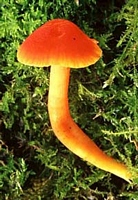
Caption: Hygrocybe firma
Owner: Kaimai Bush | 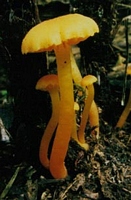
Caption: Hygrocybe firma
Owner: Kaimai Bush | 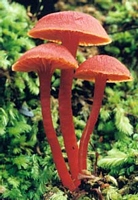
Caption: Hygrocybe firma
Owner: Kaimai Bush | 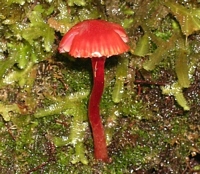
Caption: FUNNZ photo
Owner: J.A. Cooper | 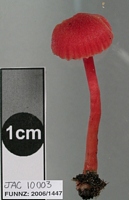
Caption: FUNNZ photo
Owner: J.A. Cooper | 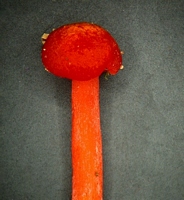
Caption: FUNNZ: 2006/0416, See public note for more information
Owner: FUNNZ | 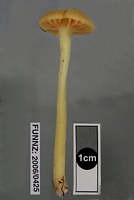
Caption: FUNNZ: 2006/0425, See public note for more information
Owner: FUNNZ | 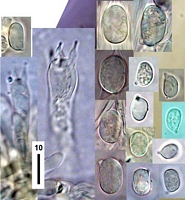
Caption: dimorphic spores and basidia
Owner: J.A. Cooper | 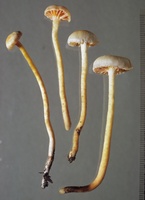
Caption: ZT71-084
Owner: E. Horak: © Creative Commons Attribution-Noncommercial 3.0 New Zealand | 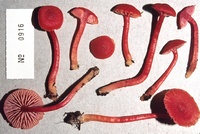
Caption: ZT0916
Owner: E. Horak: © Creative Commons Attribution-Noncommercial 3.0 New Zealand | 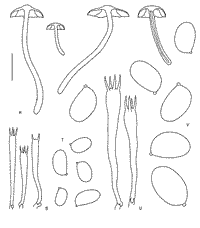
Caption: Fig. 1 Hygrocybe firma (Berk. & Br.) Sing. (R-V: ZT 916):
R. basidiomesS. microbasidia. T. microspores. U. macrobasidia. V.
macrospores. | 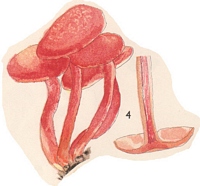 | 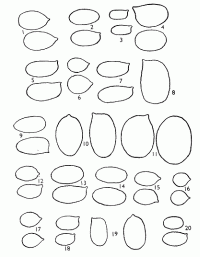
Caption: Spores X 2000 1. Hygrophorus salmonipes 2; H. elsae; 3, H .julietae; 4, H. variabilis; 5, H. lilaceo-lamelllatus; 6, H. muritaiensis; 7, H. keithgeorgei; 8, H. pseudococcineus; 9, H. rubro-carnosus; 10, H. miniceps; 11, H. procerus; 12, H. multic |
Article: Horak, E. (1990). Monograph of the New Zealand Hygrophoraceae (Agaricales). New Zealand Journal of Botany 28(3): 255-306 (http://www.rsnz.org/publish/abstracts.php).
Description: Pileus-30 mm, hemispherical to plano-convex with obtuse umbo, overmature specimens
sometimes with subdepressed centre; brilliant red (scarlet) in fresh specimens,
fading to yellow with faint orange tinge soon discolouring to pale yellow; dry,
hygrophanous, margin non-striate in dry condition, radially fibrillose, subsquamulose
or scurfy in centre due to concolorous fibrils, smooth towards subsulcate margin.
- Lamellae broadly adnate to decurrent or emarginate-ventricose, nearly triangular,
up to 7 mm wide, rather distant; concolorous with pileus turning yellow to pale
orange, entire edges concolorous. - Stipe 40-80 x 1.5 4 (-5) mm, cylindrical,
equal or gradually tapering towards base, slender, occasionally compressed and
twisted; brilliant red turning orange above but yellow to whitish at tomentose
or substrigose base; dry, smooth, solid at first becoming hollow in aged specimens,
single or caespitose. - Context concolorous with pileus, red beneath cortex
of pileus and stipe with faint orange tinge towards base of stipe. - Odour and
taste not distinctive. - Chemical reactions on pileus: KOH - negative.
Spores dimorphous, elliptical to ellipsoid, hyaline: macrospores 12-17 x 8-10.5
um; microspores 6-10.5 x 4.5-6 um. - Basidia dimorphous, 4- (and rarely also
2-) spored: macrobasidia 60-85 x 8-12um; microbasidia 40-50 (-60) x 5-6 um.
- Cystidia absent. - Pileipellis a trichoderm of cylindrical, smooth, non-gelatinised
hyphae (5-12 um diam.), terminal cells not differentiated, with yellow (KOH)
plasmatic pigment, oleiferous hyphae often present in subcutis; clamp connections
present (Pl. 1, Figs. 1, 2).
Habitat: ECOLOGY: Common; saprobic on soil among litter in mixed conifer and broadleaved
forests, rarely under Nothofagus. April-July.
Distribution: DISTRIBUTION: NZ(N, NA, SA,W). - Pantropical species with wide distribution
both in E Asia (Corner 1936; Hongo 1959, 1982) and Caribbean region (Dennis
1953;.Pegler 1983,1986).
Notes: In New Zealand H. firma is readily confused with either H. miniceps
(Stev.) Horak, H. procera (Stev.) Horak, or H. rubrocarnosa (Stev.)
Horak as these four taxa share not only basidiomes corresponding in. shape,
size, and.colours but also localities in ecologically similar situations. Microscopically
H. firma is distinguished, however, by its dimorphous basidia and spores.
The pantropical H.firma was originally reported from Sri Lanka (Berkeley
&: Broome 1871; Pegler 1986). In SE Asia the taxon is also recorded from
Malaysia where Corner (1936) demonstrated the extraordinary variation of its
macroscopical and microscopical features by recognising not less than 17 varieties
(for discussion cf. Pegler 1988).
The first New Zealand collection of H. firma was made by Stevenson;
the material, however, was erroneously referred to as H. pseudococcineus
Hongo (1955) which also represents an Hygrocybe with dimorphous spores
and basidia.
Article: Stevenson, G. (1963) [1962]. The Agaricales of New Zealand: IV. Kew Bulletin 16(3): 373–384.
Description: Pileus 2-3 cm. diam., brilliant red
with orange margin, dotted centrally with orange or yellow fibrils, plano-convex;
flesh waxy, red. Gills adnate to slightly decurrent, reddish orange with yellow
margins, thick and sometimes wrinkled, moderately distant. Stipe 4-5 cm X 4-5
mm., brilliant red, yellow at base, hollow, sometimes twisted. Spores 15 X 8-9
µm., ovoid, hyaline, thin-walled (Fig. 2/8.).
Habitat: habitat: in mountain forests under Nothofagus etc., Levin,
15.5.1948, Stevenson, Rotoiti, 16.5.1956, E. Kidson.
Notes: The writer considers that this commonly collected New Zealand fungus is clearly
referable to the Japanese species, though the New Zealand form appears to be
larger with a more slender stipe.
|